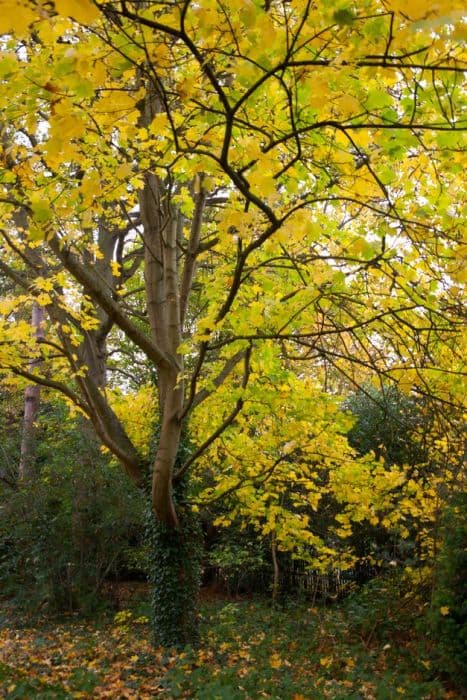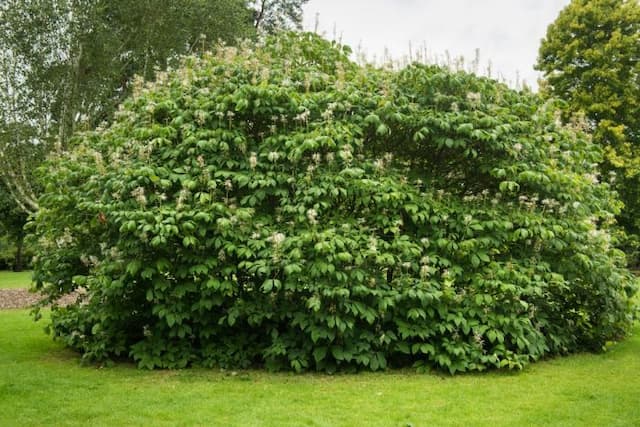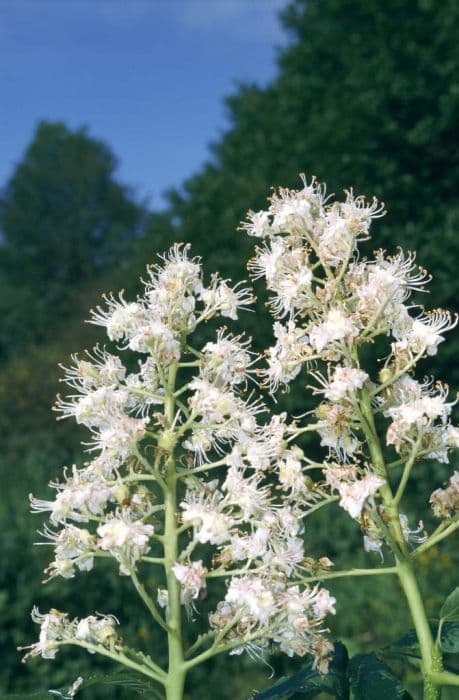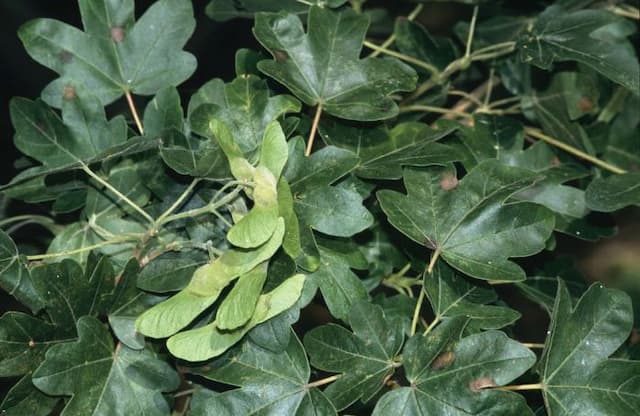Sugar Maple Acer saccharum



ABOUT
A Sugar Maple is a large deciduous tree with a straight trunk, broadly spreading branches, and a dense, oval or rounded crown. Its foliage, with five-lobed leaves measuring 3 to 6 inches, varies from medium to dark green in summer and changes to a vivid palette of yellow, orange and red in fall. In spring, greenish-yellow flowers appear in front of the leaves, gathered in short, upright inflorescences.
Sugar Maples also look good in winter when they drop their leaves. They have attractive, gray-brown bark, often ribbed.
The tree is used to make the famous maple syrup. It takes about 40 gallons of sap to produce 1 gallon of maple syrup.
It grows up to 40-80 feet tall and 30-60 feet wide.
About this plant
 Names
NamesFamily
Sapindaceae
Synonyms
Striped Maple, Rock Maple, Sugar Tree, Birds-Eye Maple, Sweet Maple, Curly Maple, Hard Maple, Leucoderme, Northen Sugar Maple
Common names
Acer saccharophorum, Acer palmifolium
 Toxicity
ToxicityTo humans
It's nontoxic to humans, including kids.
The juice is even edible and used to make maple syrup - one of America's symbols.To pets
Non-toxic to cats and dogs. However, horses may experience symptoms of poisoning after ingesting.
 Characteristics
CharacteristicsLife cycle
Perennials
Foliage type
Deciduous
Color of leaves
Changes from green to shades of yellow and red
Flower color
Yellow
Height
80 feet
Spread
60 feet
Plant type
Tree
Hardiness zones
2
Native area
Eastern Canada and the United States
Benefits
 General Benefits
General BenefitsSugar Maple is used to make maple syrup and maple sugar;
Also, used in the manufacture of hardwood lumber that used to make furniture and flooring;
Sugar Maple is important to wildlife. Elk, deer, squirrels, rabbits, hares, porcupines, mice, and many species of birds feed on maple bark, buds, branches, and fruit;
Sugar maples are some of the most beloved trees in North America. Four states have chosen this tree as their state tree - New York, West Virginia, Wisconsin, and Vermont - and it is also Canada's national tree;
The leaf of the Sugar Maple is depicted on Canada's national flag. Medical Properties
Medical PropertiesNot only is pure maple syrup high in antioxidants, but each spoonful contains nutrients such as riboflavin, zinc, magnesium, calcium and potassium;
Maple syrup has more minerals and antioxidants, but fewer calories than honey, according to Helen Thomas of the Maple Association of New York State;
Like honey, maple syrup can help reduce inflammation, redness, blemishes and dry skin;
Over the years, the medicinal properties of maple kernel have been shown to help treat rheumatism, bruises, eye ailments and pain;
Many maple varieties are high in phytochemicals and have a number of beneficial properties, such as anti-tumor and anti-inflammatory activity.
Maple syrup can only be used as an adjunct in the treatment of diseases. Do not use as a stand-alone treatment. Air-purifying Qualities
Air-purifying QualitiesAs with all trees, sugar maples absorb carbon dioxide (CO2) from the atmosphere during photosynthesis and release oxygen (O2) into the air. This process helps to remove excess CO2 from the atmosphere, which can help mitigate the effects of climate change.
 Other Uses
Other UsesSugar Maples are best known for being a major source of maple syrup, and for its brightly colored fall foliage;
Sugar maple is among the leading furniture species. This species is also used for flooring, boxes drawers, and production of veneers;
Sugar Maple is often planted as ornamental plants in parks and along roads;
Sometimes Sugar Maples planted along roads to create a shelter strip from wind and snow.
Interesting Facts
 Feng Shui
Feng ShuiIn feng shui, sugar maple trees are often seen as symbols of stability, longevity, and prosperity. They are also believed to bring positive energy, or chi, to a space.
One common practice in feng shui is to plant a sugar maple tree in the front yard of a home or business. This is said to attract abundance and good fortune, as well as provide protection and stability to the property. Zodiac Sign Compitability
Zodiac Sign CompitabilitySugar Maples compatible with all zodiac signs.
 Plant Symbolism
Plant SymbolismIn many cultures, sugar maple plants are seen as symbols of strength, endurance, and resilience:
Strength: The sugar maple is known for its sturdy trunk and strong branches, which make it a symbol of strength and durability.
Endurance: Sugar maples are long-lived trees that can survive for centuries. As such, they are often seen as symbols of endurance and the ability to weather life's challenges.
Prosperity: In addition to providing syrup and wood, sugar maple trees are often associated with abundance and prosperity. In some cultures, it is believed that planting a sugar maple tree can bring good fortune and financial success.
Autumnal beauty: Sugar maples are known for their beautiful fall foliage, which can range from bright yellows to deep oranges and reds. As such, they are often seen as symbols of beauty, transformation, and change.
 Water
WaterConstant watering is especially important while the tree is taking root in the landscape. It is best to water it once to twice a week.
After rooting, your sugar maple will need about five gallons or more of water per week. Light
LightFull sun and partial shade are best for this tree, meaning it prefers at least four hours of direct, sunlight each day.
 Temperature
TemperatureTypical ranges in temperatures are from -40° F in the north to 100° F in the southwestern areas.
The disadvantages of this tree are its susceptibility to strong winds, freezing rain and winter frosts. Pruning
PruningIt does not need regular pruning. Prune Sugar Maples only when necessary. It should be done only in late summer and early autumn to avoid non-healing wounds. Also, do not extract maple juice after the buds appear.
 Cleaning
CleaningNot needed
 Soil
SoilSugar Maple prefers well drained, rich, loam soil; however, it can grow on soils that are sandy or have neutral or alkaline soil pH.
It may struggle on clay soils. Sugar Maple does not tolerate compaction and drought and is sensitive to salt. Repotting
RepottingThis is an outdoor plant and do to be transplanted.
 Humidity & Misting
Humidity & MistingSugar maples do best in cooler, moist climates.
 Suitable locations
Suitable locationsIndoor
Not growing
Outdoor
All year round
Hardiness zone
3 - 12 USDA
 Life cycle
Life cycleSugar Maple is a very resistant plant.
Maple can be planted in spring, summer and fall, depending on the method of planting. See "Propagation" for details.
And successful sap harvest depends on temperature. It should be warm during the day and cool at night. Usually, this is late winter to early spring. Propogation
PropogationPropogation time
Spring, summer, fall
By CUTTINGS:
Growing maple trees from cuttings is an easy way to get free seedlings for your garden. Take 4-inch cuttings from the tops of young trees in mid-summer or mid-fall and remove the leaves from the lower half of the stem. Scrape off the bark on the bottom half of the stem with a knife, then coat it in powdered rooting hormone.
Stick the bottom 2 inches of the stalk into a pot filled with moist rooting medium. Maintain humidity around the plant by enclosing the pot in a plastic bag or covering it with a milk jug with the bottom cut out. Once the cuttings are rooted, release them from the cover and place them in a sunny spot;
By SEEDS:
Be sure to stratify the seeds before planting.
To improve germination, they are placed in sand or peat in the fall and kept in the sand at no more than 37 degrees.
It is not necessary to take the seeds out of the wings. Sown in April. The soil should be moist and fertilized, the optimal depth - 1,5 inches. Emergence of sprouts should be expected in two weeks.
 Pests
PestsMaple leafcutter moth, Aphid
 Diseases
DiseasesSapstreak, Tar spot, Verticillium wilt, Lichen, Root Rot, Powdery mildew









